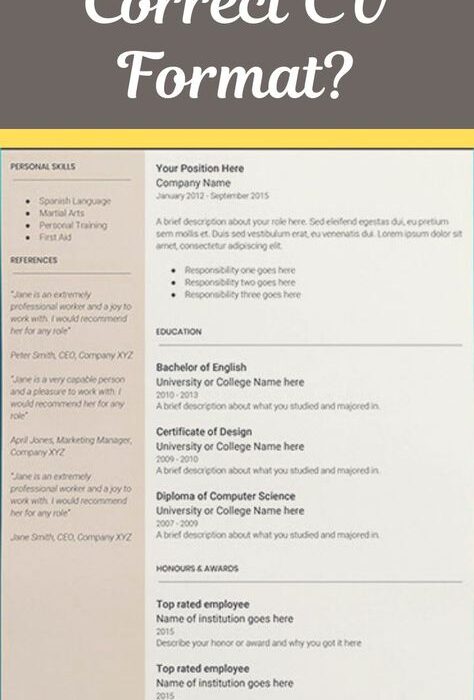Your resume could be holding you back from landing interviews. Many talented professionals in Texas, California, New York, and Florida miss out on opportunities simply because their CV formatting doesn’t make the right impact.
Why Does Your CV Format Really Matter?
Hiring managers spend only a few seconds glancing at each resume. During that brief moment, they judge whether you’re worth their time based largely on how your document looks.
A cluttered or confusing layout can make even the most qualified candidate appear unprofessional. Your CV formatting speaks volumes before anyone reads a single word about your experience.
Making Those First Seconds Count
Recruiters review countless applications daily. Your CV needs to grab attention immediately and make finding information easy for busy readers.
Think of formatting as the packaging for your professional story. Good packaging makes people want to learn more about what’s inside.
Building Blocks of Strong CV Formatting
Creating Your Header Section
Your header needs these components:
- Name displayed prominently at the top
- Email that sounds professional
- Working phone number with correct area code
- Location listed as city and state (Houston, Texas)
- LinkedIn URL if your profile is complete
- Portfolio website when relevant to your field
Skip personal details like birth date, relationship status, or photographs unless an employer specifically asks for them.
Making Contact Information Work
Choose an email address that includes your actual name. Something like “john.smith@email.com” works better than creative but unprofessional alternatives.
Always include your full phone number. Texas employers appreciate knowing you’re local or willing to relocate.
Organizing Your CV Content
Starting With a Strong Summary
Write 2-3 sentences highlighting your main qualifications. This snapshot appears below your header and tells employers why they should keep reading.
Focus on what makes you valuable. Match your summary to the specific job you’re applying for.
Presenting Your Work History
Always start with your current or most recent job and work backward. Each position should show:
- Your role or title
- Where you worked
- When you worked there (month and year)
- 3-5 brief points about what you accomplished
- Numbers that prove your impact
Listing Education and Training
Put your most recent degree at the top. Add any certificates or special training that relates to the job you want.
Recent graduates might place education before experience. Everyone else typically puts work history first.
Smart Formatting Choices
Picking the Right Font
Stick with fonts that look professional:
- Arial works well for modern industries
- Times New Roman suits traditional fields
- Calibri reads easily on screens
- Helvetica appears clean and simple
Body text should be 10-12 points. Make headings 14-16 points. Don’t mix multiple fonts in one document.
Using Space Wisely
Good spacing makes reading easier. Follow these guidelines:
- Set margins to one inch all around
- Use single spacing inside each section
- Add double spacing between different sections
- Keep bullet points aligned consistently
Cramming too much onto one page makes everything harder to read. Give your content room to breathe.
Working With Bullet Points
Break up long paragraphs with bullet points. Start each one with an action word:
- Led
- Created
- Improved
- Launched
- Streamlined
Each bullet should be one or two lines maximum. Shorter points are easier to scan quickly.
Mistakes That Cost You Interviews
Mixing Styles Throughout
Using different fonts or spacing styles looks sloppy. Pick one approach and stick with it everywhere.
Check that all your dates follow the same pattern. Make sure every bullet point uses the same format.
Cramming in Too Much
You don’t need to list every job you’ve ever had. Focus on recent, relevant experience that matches what employers want.
Most people need just 1-2 pages. Only very senior professionals might need three pages.
Burying Important Information
Put your best qualifications up front where they’re easy to find. Don’t hide key skills in the middle of long paragraphs.
Clear headings help readers jump straight to what they want to see.
Getting Your CV Past Computer Screens
Choosing Your File Type
Save your CV as a PDF to keep formatting intact. Different computers display Word files differently.
Name your file clearly: “JaneSmith_Resume.pdf”
Beating Applicant Tracking Software
Companies use programs to screen resumes automatically. Help your CV pass these tests by:
- Using standard heading names
- Skipping fancy graphics or designs
- Including keywords from job postings
- Avoiding complex tables or columns
Testing Online Applications
Upload your CV to a few job sites and see how it looks. Sometimes formatting gets messed up during the upload process.
Keep a simple text version ready for systems that don’t accept formatted files.
CV Formatting for Texas Industries
Tailoring to Your Field
Different industries across Texas have unique expectations:
Energy Jobs:
- Highlight safety training
- Show project leadership
- List technical abilities
Tech Positions:
- Feature coding skills
- Link to your work samples
- Demonstrate ongoing education
Healthcare Roles:
- Display licenses first
- Include patient interaction
- Mention regulatory knowledge
Showing Local Connections
Texas employers value community ties. Mention professional groups you belong to or volunteer work in the area.
Advanced Strategies That Work
Placing Keywords Thoughtfully
Look at job ads in your field and note words that appear repeatedly. Weave these naturally into your experience descriptions.
Never just list keywords randomly. They need to fit naturally within real sentences about your work.
Adding Numbers for Impact
Specific numbers prove what you’ve accomplished:
- “Boosted revenue by 30%”
- “Supervised 8 staff members”
- “Cut expenses by $75,000 yearly”
Using Strong Action Words
Begin bullet points with verbs that show you take initiative. This makes your experience sound more impressive and engaging.
Getting Professional Formatting Help
When Outside Help Makes Sense
Consider CV formatting services when:
- Switching to a new career path
- Explaining time away from work
- Applying for executive positions
- Struggling with design
- Needing industry-specific knowledge
Professional writers know what works now and can position you for success.
Tools You Can Use Yourself
Several platforms help you create polished CVs:
- Canva offers customizable templates
- Resume.com walks you through the process
- LinkedIn lets you export your profile
- Google Docs makes sharing easy
Many include templates designed to pass applicant tracking systems.
Common Questions About CV Formatting
How long should my CV be?
One page works for newer professionals. Experienced workers typically need two pages. Only include information that’s recent and relevant to the job you want.
Do I need a photo on my CV?
No, American employers don’t expect photos and may actually prefer CVs without them. Only add a photo if someone specifically requests one.
When should I update my formatting?
Check your CV every year or whenever you start looking for new opportunities. Outdated formatting can make you seem out of touch.
Should every CV look the same?
Keep your basic format consistent, but adjust the content for each application. Highlight different skills and experiences based on what each employer wants.
What format do online systems prefer?
PDF usually works best because it preserves your layout. Some systems work better with Word documents, so always check the application instructions.
Can I use color in my CV?
Subtle color accents work in creative fields. Traditional industries prefer black text on white backgrounds. Never use colors that make text hard to read.
Final Thoughts
Strong CV formatting opens doors across Texas, California, New York, and Florida job markets. Your document’s appearance can make or break your chances before anyone reads about your qualifications.
Focus on creating a clean, organized layout that guides readers through your story effortlessly. Combine smart formatting with compelling content that shows what makes you valuable.
Take action today by reviewing your current CV against these guidelines. Small improvements in presentation can lead to big improvements in your job search results.





